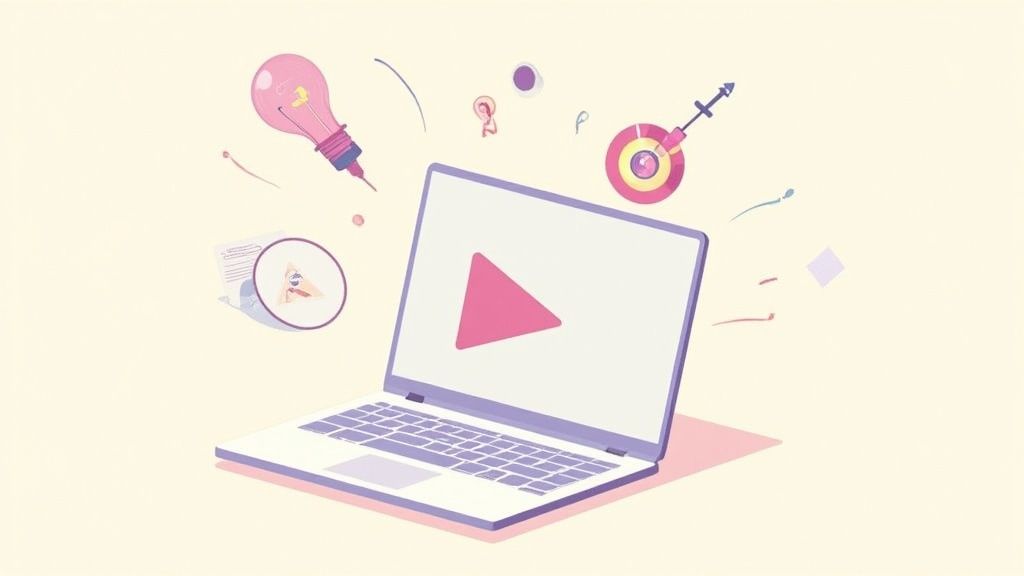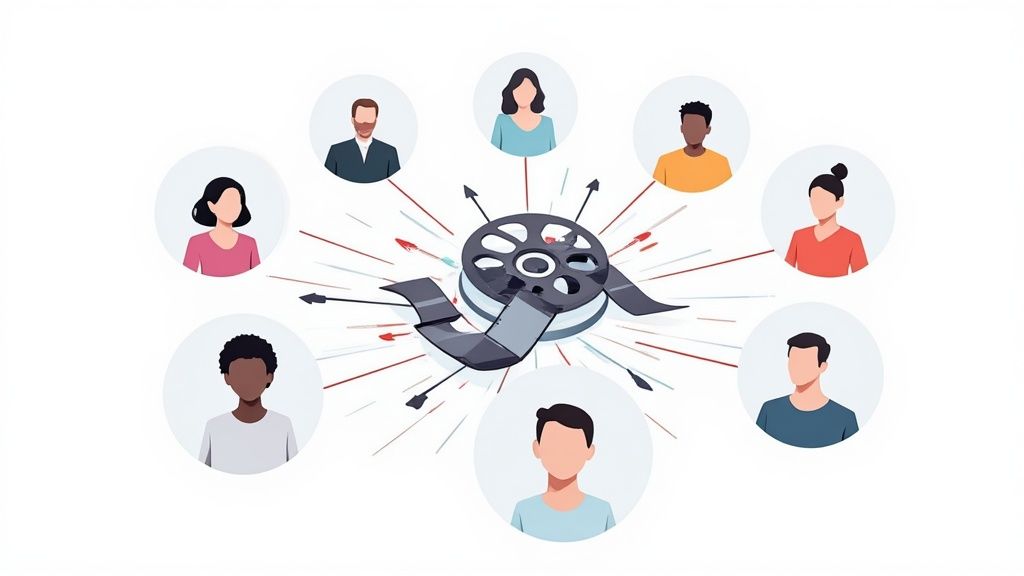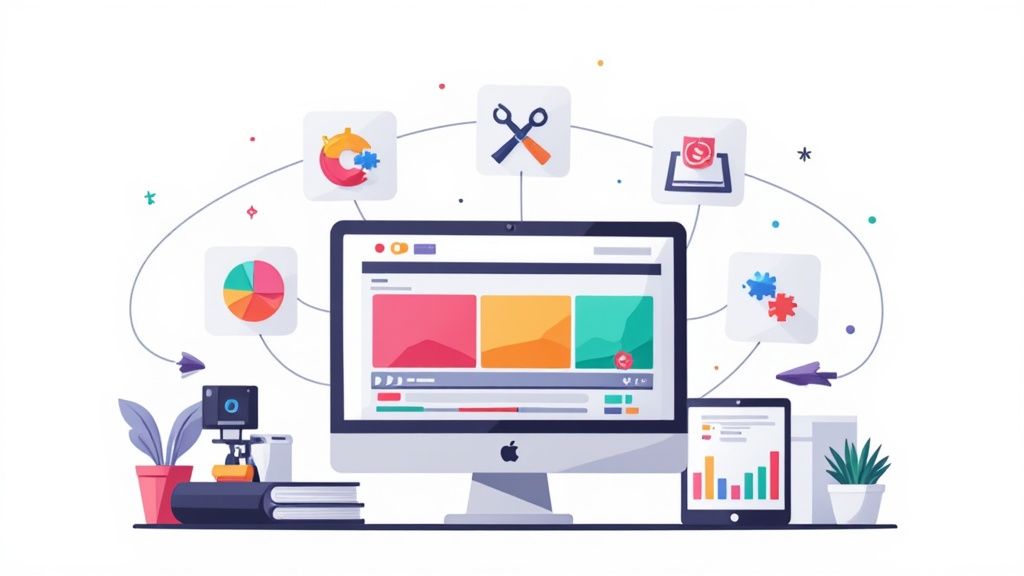How To Create & Deliver A Killer Software Demo Presentation



How To Create & Deliver A Killer Software Demo Presentation: Tips & Guide
Creating and delivering a killer software demo isn't about showing off every bell and whistle. It's about a fundamental shift in focus: you have to stop talking about features and start demonstrating solutions.
The real secret is to show precisely how your software solves your prospect's most pressing problems, wrapping it all in a compelling story. This one change transforms a generic product tour into a personalized, problem-solving conversation—the kind that actually drives decisions.
The Anatomy Of An Unforgettable Software Demo

Forget the feature-dump monologues of the past. Today's best demos are strategic conversations, not robotic walkthroughs. The most common mistake I see is people treating their demo like a checklist of functions, a surefire way to disconnect from the audience and their real-world headaches.
The modern framework puts the prospect's world front and center. It’s all built on a foundation of deep preparation, storytelling, and proactive follow-up.
From Presentation To Problem-Solving
The big idea here is to move from presenting software to solving problems. Your prospect doesn't actually care about a button labeled "Export to CSV." What they do care about is getting critical data to their finance team before the end of the quarter without spending hours on manual data entry. See the difference?
Your ultimate goal is to make the decision to buy feel like the only logical next step. Every single part of your demo should build toward this conclusion by connecting their specific pain points directly to your software's value.
This approach demands that you understand their world so well that the demo feels less like a sales pitch and more like a strategy session with an expert consultant. Crafting this kind of https://www.moonb.io/blog/product-demos-experience is what separates the pros from the amateurs, making the demo feel both enlightening and absolutely essential.
Why The Old Way Fails
A feature-first demo fails because it forces the prospect to do all the heavy lifting. They're left trying to mentally translate your software's functions into solutions for their unique operational nightmares. Most won't bother.
Top performers, on the other hand, transform a standard presentation into a memorable sales experience by focusing on these core principles:
- Deep Preparation: Knowing the prospect's industry, role, and specific pain points before the call even begins.
- Narrative Storytelling: Weaving features into a "day-in-the-life" story that paints a clear picture of a better future.
- Strategic Focus: Showing only what is necessary to solve their biggest problems. This creates a powerful, uncluttered message.
To truly build an unforgettable demo, you first need to understand the different formats and how they work. For a deep dive into modern techniques, I highly recommend exploring these resources on interactive product demos, their benefits, and best practices. Getting this groundwork right will set you up for success from the start.
This evolution in sales strategy is clearly reflected in the market. The global sales presentation and demo software market, valued at USD 1.2 billion, is projected to hit USD 3.1 billion by 2033, a clear sign that businesses are investing heavily in more engaging virtual selling.
A truly killer software demo is built on a few essential components. I've broken them down into what I call the "Core Pillars" that differentiate an average demo from an exceptional one.
Core Pillars Of A Killer Software Demo
Mastering these pillars ensures your demo is not just seen, but felt. It becomes a collaborative session where the prospect sees their own success mirrored in your software.
Mastering Pre-Demo Discovery and Research
The success of your software demo is decided long before you ever share your screen. I’ve seen it time and time again: a killer presentation isn't built on flashy features, but on a deep, strategic understanding of your prospect’s world. Skipping this phase is like trying to solve a puzzle without looking at the box—you might jam a few pieces together, but you’ll never see the full picture.
This isn’t just about a quick glance at their LinkedIn profile or company "About Us" page. Real mastery comes from digging deeper. You need to uncover the specific pain points, business objectives, and existing tech stack that define their daily reality. It's all about building a solid foundation for your demo.
Going Beyond Surface-Level Research
Your first mission is to get a handle on the prospect’s ecosystem. I'm talking about their company news, recent press releases, and even what their competitors are up to. Are they in a growth phase? Trying to cut costs? This context is gold because it helps you frame your solution in a way that clicks with their highest-level business goals.
To really nail this, you have to genuinely understand your market and potential clients. Learning how to conduct effective market research even with limited resources will give you a massive advantage, letting you tailor your approach with surgical precision. This knowledge transforms your demo from a generic pitch into a bespoke consultation.
This process chart gives you a great visual workflow for structuring your demo based on that initial research.
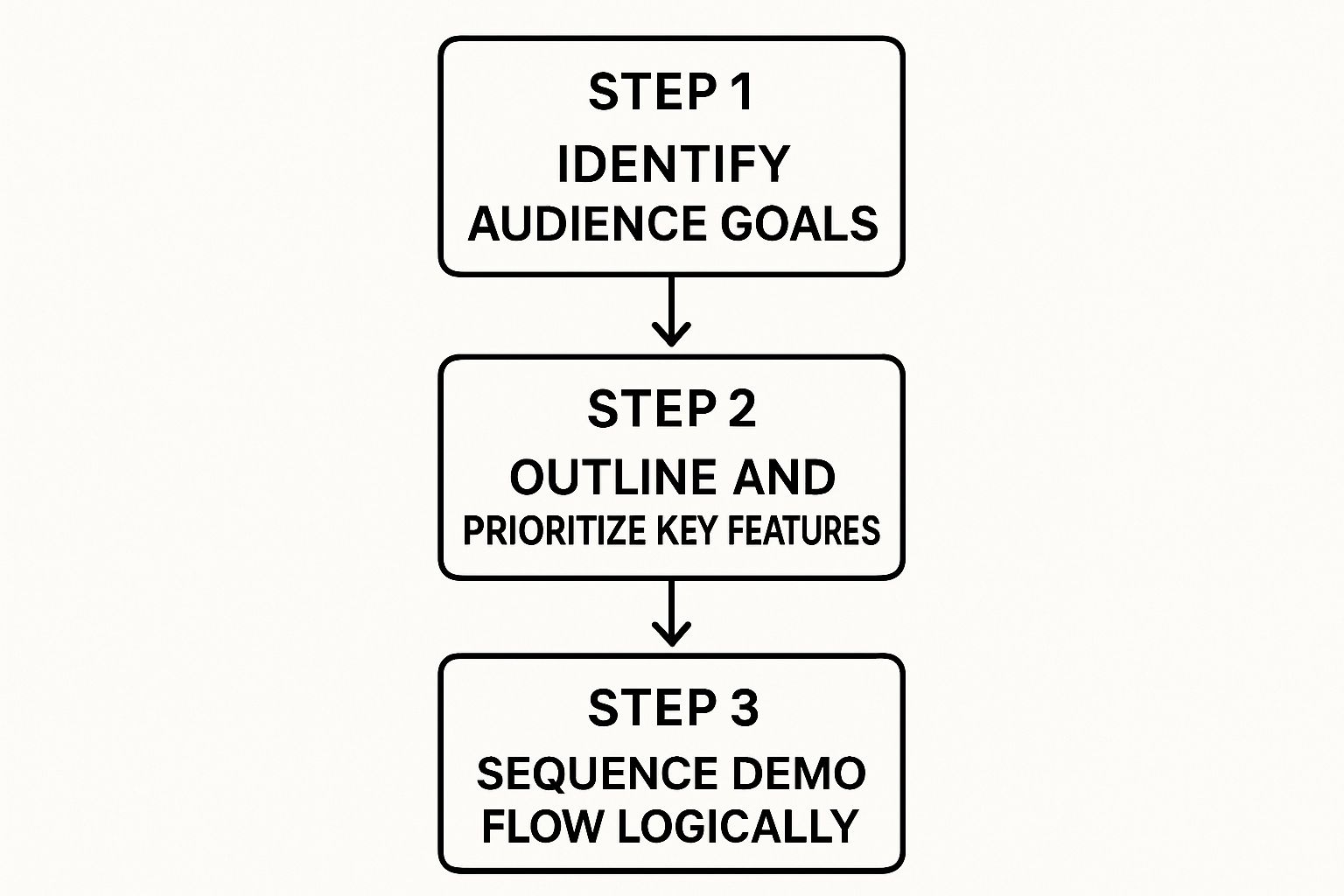
As you can see, a winning demo flow starts with the audience's goals, zeroes in on the features that actually solve their problems, and then sequences the presentation logically to tell a compelling story.
Asking The Right Discovery Questions
The discovery call is your single most important tool. This is your chance to move from educated guesses to hard facts. The key is to ask open-ended questions designed to uncover not just the problems, but the impact of those problems.
Instead of a broad question like, "What are your biggest challenges?" try getting more specific:
- "Could you walk me through your current process for [specific task]? What parts of that feel clunky or frustrating?"
- "If you could wave a magic wand and fix one thing about your current workflow, what would it be and why?"
- "What key metrics is your team responsible for, and how are you currently tracking progress toward those?"
Questions like these don't just identify pain; they quantify it. They give you the exact language and real-world scenarios you need to build a demo narrative that truly resonates. You can find more practical tips on this in our guide explaining how to educate customers about your product.
The goal of discovery is not to gather data; it’s to gather ammunition. Every answer a prospect gives you is a piece of evidence you can use to build an airtight case for your software.
This approach ensures that every single minute of your demo feels like it was made just for them, making the value of your solution obvious and undeniable.
Connecting Their Challenges To Your Solution
Once you have a crystal-clear picture of their pain points and goals, the final step is to map them directly to your software’s capabilities. This is where you actually build the "story" for your demo. Fight the temptation to show off every single cool feature your product has. Nobody has time for that.
Instead, I recommend creating a simple two-column list. It’s a game-changer.
This simple exercise becomes the blueprint for your entire software demo. It forces you to be disciplined and ensures every feature you present is a direct answer to a question they’ve already asked. By focusing only on what matters to them, you show respect for their time and prove you were actually listening.
Crafting A Narrative That Sells
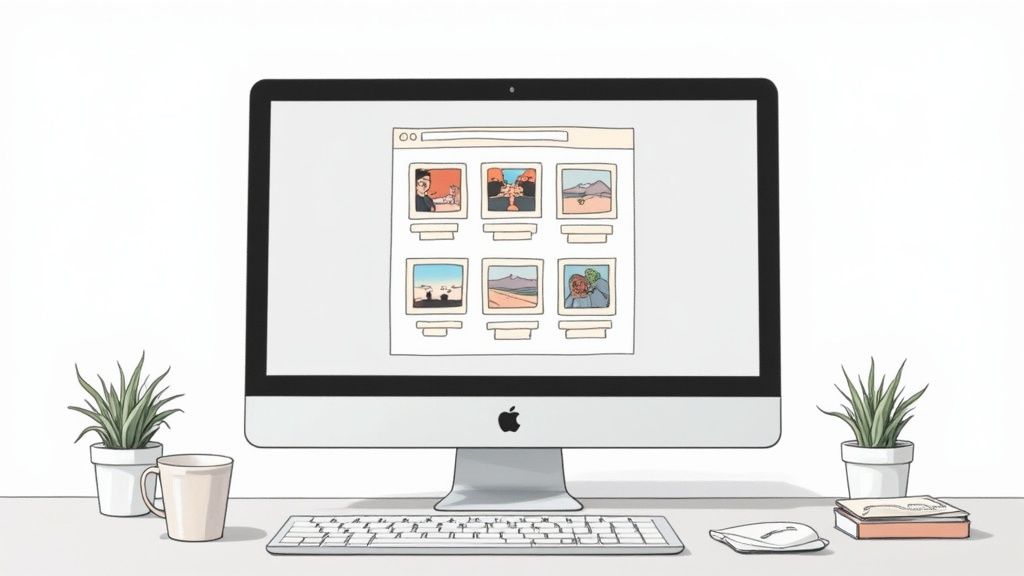
Let's get one thing straight: people rarely remember a laundry list of features, but they never forget a good story. This is the secret to elevating a software demo from a simple walkthrough to a truly persuasive experience.
Your mission isn't just to show what your software does. It's to tell a story about why it matters to your prospect. This means throwing the old feature-by-feature tour out the window. Instead, you'll frame your software as the hero in your prospect's story, creating an emotional connection that raw data and specs just can't touch. When you do it right, the decision to buy feels like the only logical conclusion.
The Problem-Solution-Value Arc
The most effective narrative for a software demo is a classic for a reason. It's a simple but incredibly powerful storytelling arc tailored for business: Problem, Solution, Value. This framework gives your presentation a natural flow that prospects can easily follow and connect with.
It works because it mirrors how people make decisions. We identify a problem, look for a solution, and then weigh the potential outcome. Structuring your demo this way feels less like a sales pitch and more like a consultative conversation.
Here’s how to think about the three acts of your demo story:
- The Problem: Start by painting a clear picture of the prospect's main pain point. Use the exact language they shared during your discovery calls—it shows you were actually listening. This part isn't about your software yet; it’s all about their world and their challenges.
- The Solution: Now, introduce your software as the specific answer to that problem. This is where you connect their pain directly to your features, showing exactly how your product solves their issue.
- The Value: Finally, show them the "after" picture. What does their world look like once the problem is gone? This is where you hit them with tangible business outcomes like saved time, lower costs, or more revenue.
Creating A Day-In-The-Life Scenario
The best way to bring this story to life is to ground it in reality with a "day-in-the-life" scenario. You're essentially walking the prospect through a typical workflow, first highlighting the struggle without your software, and then showing the seamless efficiency with it.
Let's say you're demoing a project management tool to a marketing director who's drowning in chaotic campaign launches. Your narrative could go something like this:
- Problem: "You mentioned that right now, managing a campaign launch involves dozens of emails and tracking three different spreadsheets, which often leads to missed deadlines."
- Solution: "Let me show you how our platform centralizes all of that. Here's the campaign dashboard where you can see every single task, owner, and deadline in one place."
- Value: "With this single view, your team saves an estimated five hours per week on status updates alone, and you can get campaigns out the door 20% faster."
This approach makes your value prop undeniable because it’s framed in a context they live every single day. The more your demo reflects their reality, the more compelling it becomes. To really nail this, it helps to understand the fundamentals of narrative structure, and exploring the art of corporate storytelling can give you a much deeper framework.
A great demo is not an endless display of features and functions; it’s a story about how your solution will improve your prospect’s work and life. Meaningful, real examples told in a flowing, story-based manner are dramatically more valuable than clicking through menus.
This broader shift toward more engaging presentations is happening everywhere. The global presentation software market, valued at USD 5.9 billion in 2023, is expected to explode to over USD 20.8 billion by 2032. This growth is fueled by the corporate world's demand for more dynamic ways to deliver content.
From Hook To Compelling Close
Like any good story, your demo needs a strong beginning and end. Think of it like a movie: you need an opening that grabs their attention and a finale that leaves a lasting impression.
The HookKick off your demo with a powerful opening that ties directly to their biggest business goal. Don't waste a second on generic pleasantries. A great hook can be a provocative question or a bold statement based on your earlier conversations.
- Weak Hook: "Thanks for your time today. I'm going to show you our software."
- Strong Hook: "On our last call, you said your biggest goal for Q3 is to cut customer churn by 15%. I'm going to show you exactly how our platform helps you hit that number."
The CloseWrap things up by summarizing the value and painting a clear picture of their future success. Reconnect the key problems you've solved to their high-level business goals. The close isn't about features; it's about their transformation.
Your final words should make the next step feel like the most natural thing in the world. Instead of a weak "Any questions?" guide them forward. Try something like, "Based on what we've covered, the clearest next step is to get your team leads into a trial so they can experience this efficiency for themselves." This smoothly transitions the story from a demonstration into their reality.
Executing The Demo With Confidence
This is it. The moment where all your prep work pays off. Delivering a killer software demo isn't about a flawless, robotic speech—it’s about leading a confident, engaging conversation. Your job is to guide the prospect through their story, where your software emerges as the hero.
The real skill lies in managing the flow of the conversation, keeping the energy up, and handling any curveballs with grace. This is where you build trust and prove your expertise, turning a simple screen share into an experience that makes the prospect feel completely understood.
Setting The Stage For Success
Before you even think about hitting "Share Screen," you need to own the environment. For virtual demos, that means more than just double-checking your Wi-Fi. Make sure your lighting is decent, your background looks professional, and you've silenced every last notification. Nothing torpedoes momentum like a random Slack message popping up mid-sentence.
Even more critical is setting a clear agenda right from the start. Give them a quick recap of the problem you're there to solve and an outline of what you'll cover. It shows you respect their time and gives everyone a mental roadmap to follow, which is key to keeping them focused.
Remember, confidence is contagious. When you're calm and in control, your audience feels it. This isn’t about being perfect; it's about being prepared and present.
This initial setup doesn't just look professional; it positions you as a credible guide who is about to lead a valuable discussion, not just a salesperson going through the motions.
Navigating The Live Demonstration
Once the demo is live, your pacing and tone become everything. Speak clearly and consciously avoid rushing. After you reveal a key feature or a major value point, pause. Let it sink in. Give them a moment to connect the dots and imagine what that means for their business.
Think of yourself as a tour guide, not a lecturer. Instead of a dry play-by-play like, "Now I'm clicking the analytics button," frame it around their needs: "And here's where you'll find the insights to finally clear up that reporting bottleneck we talked about." Always tie the "what" (the feature) back to their "why" (the problem).
A great presentation should feel like a two-way street. To keep them locked in:
- Ask Check-In Questions: Simple prompts like, "Does this make sense so far?" or "Can you see your team using this?" are perfect for turning a monologue into a dialogue.
- Use Their Language: Refer back to the specific pain points they shared during discovery. "Remember how you said the team struggles with X? This is the exact feature that solves that."
- Keep It Conversational: Your delivery should be polished, but not so rehearsed that it sounds canned. A solid software demo script is a great safety net, but you shouldn't sound like you're reading it off a screen. We've got a whole article on building a flexible one that helps.
Handling Hiccups And Hard Questions
No matter how many times you practice, things can go sideways. A feature might lag, a page won't load, or a prospect throws a question at you that you just can't answer. How you handle these moments is what separates the pros from the amateurs.
If a technical glitch pops up, don't panic. Acknowledge it calmly—"Looks like we're having a bit of a slow moment here"—and either use the time to answer a question or pivot to another part of the demo. Your composure is far more memorable than the glitch itself.
And when you get a tough question you don't have an answer for? Honesty is your only move. Making something up on the spot is the fastest way to lose all credibility. A confident reply like, "That's an excellent question. I want to make sure I get you the right information, so let me confirm with our product team and I'll follow up with a detailed answer this afternoon," actually builds a ton of trust.
The push for automation is also changing how demos are delivered, creating new expectations for seamless presentations. The global demo automation software market hit USD 2.1 billion in 2023 and is only getting bigger, especially as businesses in North America look for ways to make their sales processes more efficient. You can find more insights into the demo automation software market growth and its key drivers online. This trend really highlights just how important a polished, reliable delivery has become, whether you're live or using automation.
Perfecting Your Post-Demo Follow-Up

The deal isn't won when the Zoom call ends. Let's be real—what happens after the presentation is often what separates a stalled opportunity from a signed contract.
This is your moment to maintain momentum. A strategic, multi-touch follow-up is the engine that drives the deal forward and reinforces every ounce of value you just demonstrated.
This isn't about sending a generic "thanks for your time" email. It's about creating a clear path forward, arming your champion with the tools they need to sell internally, and proving that you're a true partner. Neglecting this stage is like running a marathon and stopping ten feet from the finish line.
Sending The Perfect Follow-Up Email
Your first follow-up should land in their inbox within a few hours of the demo. The goal is simple: be prompt, personal, and prescriptive. Think of this email as a concise summary and a roadmap for what comes next.
Don't send them a wall of text. No one has time for that. Instead, structure your email for maximum impact and scannability. Your contact is busy, so make it dead simple for them to grasp the key takeaways and share them with other decision-makers.
A winning follow-up email always includes these core components:
- A Personalized Recap: Reference specific "aha!" moments from your conversation. Mention a key problem they brought up and remind them exactly how your software solves it.
- A Summary of Key Value Points: Use bullet points to list the main benefits you discussed. Crucially, connect each one back to their stated business goals.
- Essential Resources: Always, always, always include a link to the demo recording. This is a non-negotiable asset for your champion to share internally.
- Clearly Defined Next Steps: Be explicit. State precisely what should happen next. Whether it's a technical call, a proposal review, or an intro to another stakeholder, leave zero room for ambiguity.
A great follow-up email doesn't just summarize what happened; it creates forward momentum. Its primary job is to make it incredibly easy for your champion to say "yes" to the next step and sell your solution to their team when you're not in the room.
Maintaining Momentum Without Being A Nuisance
After that first email goes out, the real art begins. You need to stay top-of-mind without becoming a pest. A well-timed sequence of helpful resources is the best way to keep the conversation warm and add value at each touchpoint.
For example, a few days after sending the recording, you might share a relevant case study featuring a company in their industry. This provides social proof and helps them visualize their own success story. If they mentioned a specific integration challenge, sending a link to your technical documentation shows you were listening and are already thinking ahead.
This entire strategy is about empowering your contact to be an effective internal advocate. When they forward your email with the case study to their CFO, they are selling on your behalf.
Ultimately, a strong follow-up contributes to better user buy-in down the line. To learn more about this, check out our guide on how to increase product adoption, as the principles start long before the sale is final.
The key is to make every interaction valuable. Don't just "check in"—share something useful that reinforces the narrative you built during your killer software demo. This thoughtful persistence demonstrates your commitment and keeps your solution at the forefront of their mind.
Answering Your Most Common Software Demo Questions
Even when you’ve nailed the narrative and practiced your flow, you’re going to run into questions and curveballs. It’s just part of the game. I’ve heard just about every question in the book over the years, so I’ve pulled together some quick, real-world answers for the most common ones.
Think of this as your cheat sheet for handling those tricky “what if” moments. Getting these right will make you look like a seasoned pro, ready for anything.
How Long Should A Software Demo Be?
There's no one-size-fits-all answer here, but if you're looking for a ballpark, the sweet spot is typically 20-45 minutes. That's usually enough time to tell a great story and show your value without seeing people's eyes glaze over.
But honestly, the real answer depends entirely on who’s in the room. A high-level demo for executives who only care about business impact might be a tight 15 minutes. On the flip side, a deep-dive for a technical team could easily push an hour. Always, always confirm the time slot beforehand and build your demo to fit, leaving at least 10-15 minutes at the end for Q&A.
It's far better to leave your audience wanting more than to have them checking the clock. Use what you learned in discovery to be ruthless about what you show—stick to the absolute must-haves that prove your value.
This isn’t just about being concise; it’s about respecting their time. It forces you to focus only on the features that solve their biggest headaches, which is all they really care about anyway.
What Is The Biggest Mistake To Avoid During A Demo?
Easy. The "show up and throw up." We’ve all seen it. The presenter just opens the floodgates and gives a generic, feature-by-feature tour of the entire product with zero connection to the prospect's actual business.
It’s a dead giveaway that you didn't do your homework. They don't give a damn about every button and menu. They care about fixing their specific, expensive problems. A great demo feels like a consultation, not a lecture.
The fix is simple: problem first, then feature. Before you click on anything, state the business problem it solves. Even better, use their exact words from your discovery calls. This one little shift turns a boring product tour into a problem-solving session that builds instant trust.
How Do I Handle Tough Questions Or Bugs?
In these moments, honesty and composure are your superpowers. Sooner or later, you'll get a question you can't answer or a technical glitch will pop up. It happens. How you react is what they'll remember.
If you don't know the answer to a question, never, ever guess. Just say, "That's a great question. I want to make sure I get you the right information, so I'll check with our product team and get back to you in my follow-up email." This builds way more credibility than fumbling through a wrong answer.
And when a bug appears or the software lags? Don't just ignore it and hope they didn't see. They saw. Just acknowledge it calmly.
- For a bug: "Looks like we're seeing a feature we're actively refining. I can't show you that specific workflow live today, but let's talk about how our roadmap is addressing that need."
- For a delay: "Looks like the demo gods are taking a coffee break. While that loads, let's jump over and discuss how your team would actually implement..."
This turns a potential disaster into a moment of transparency, showing them you’re a calm, professional problem-solver.
Should I Use A Script For My Software Demo?
A rigid, word-for-word script is a terrible idea. It makes you sound like a robot and completely torpedoes any chance of building a natural connection. You can’t adapt, you can’t read the room, and you certainly can’t have a real conversation.
Ditch the script. Instead, build a flexible storyboard or an agenda with key talking points. This is your roadmap, not a teleprompter. It should outline your core narrative:
- The key prospect problems you're going to hit on.
- The sequence of solutions (your features) you'll present.
- The main value proposition for each of those solutions.
- A couple of engaging questions to ask the audience along the way.
This framework keeps you on message without boxing you in. Practice your key points until they feel natural, but don't memorize them line-for-line. The goal here is confident flexibility, not a flawless performance.



